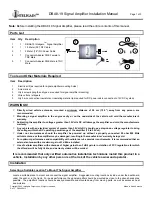
The signals which have to be analyzed run through analogue amplification stages whose
3 dB bandwidth is 250 kHz. They are converted with a 40 MHz sampling rate. The whole
lock-in analysis is realized in a fully digital design. The digital oscillator output signal is
D/A-converted with a rate of 40 MHz and amplified to provide the reference output for
the user.
All internal signals marked in green (output) or blue (input) color are handled with
approx. 40 kHz rate, so that the shortest time constant available in the system is 25
µ
s.
Further 96 bit digital low-pass filters extend the time constant range up to 1 ks. The
user has access to all lock-in inputs and lock-in outputs as well as to 8 additional
analogue input channels AUX-In which are converted with 24 bit @ 40 kHz.
Out of this signal variety, the user selects 4 signals in order to display them in acquired
frequency spectra or in the oscilloscope screen.
Besides these general functions, the eLockIn203 provides:
32 Megabytes of internal data storage
USB connection for external flash memory
(
USB flash drive
)
Remote Control via Ethernet access
HTTP-Server
6 (58)
Figure 2: Schematic of the input stage describing the switching between the three input
modes A,
A-B
and A &B as well as the position of the input amplification stages in order
to realize the three different input gains.
Summary of Contents for eLockIn 203
Page 52: ...7 APPENDICES 7 1 SCHEMATIC DIAGRAM OF THE SIGNAL PATHS 52 58...
Page 53: ...7 2 DIAGRAM OF THE LOCKIN AMPLIFICATION PATHS Diagram of the preamplifier switches 53 58...
Page 54: ...7 3 FRONTPANEL DIMENSIONS 54 58...
Page 55: ...7 4 INSTRUMENT SPECIFIC TEST SHEETS insert with 10 pages of data 55 58...
Page 56: ...7 5 PREAMPLIFIER CONNECTOR PINOUT 56 58...
Page 58: ...7 7 TRACEABILITY CHART 58 58...






































